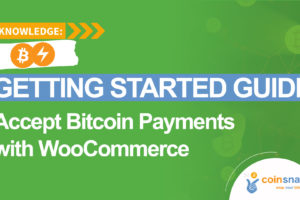How-To: Set up WooCommerce Bitcoin Payment with Coinsnap in 10 Minutes

Here’s what you’ll get in this 10-minute guide: a quick look at the WooCommerce-supported Bitcoin plugin options vs. the wider WordPress repository, a plain-English overview of Coinsnap for WooCommerce (Lightning + on-chain, no KYC/KYB for BTC/LN payouts, BTCPay Server wizard, optional fiat off-ramp via Bringin/DFX), and a fast, no-code setup you can follow step by step—from install to your first €1 Lightning test.
We’ll also cover smart defaults (rate-locking, on-chain fallback), basic compliance/accounting pointers, and quick fixes for common pitfalls so you can go live with confidence today.
After you’ve read this article, you certainly will know how to add Bitcoin to WooCommerce and how to setup WooCommerce Bitcoin in 10 minutes!
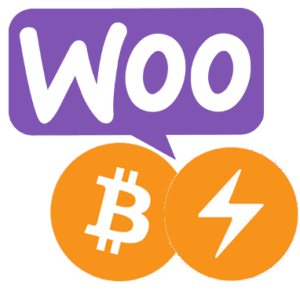
Why WooCommerce Lightning payments in 2025
Card fees negatively impact your margin, fraud and chargebacks are costly, and cross-border payments still create friction.
Adding Bitcoin Lightning to WooCommerce gives you (near-) instant settlement, tiny fees, and a more private, global checkout.
The best part: you don’t need to code or rebuild your store–with the right plugin, you will be live in minutes!
Woo Marketplace vs WordPress Plugins (Bitcoin Options)
WooCommerce doesn’t ship Bitcoin out of the box. The Woo.com Marketplace keeps a small, curated set of crypto extensions (e.g., Coinbase Commerce, DePay, Helio Pay, OpenNode). That curation is helpful for quality and support, but it also limits choice—especially if you want Lightning or non-custodial settlement:
Coinbase Commerce offers Lightning payment, but only if merchant AND customer own a Coinbase wallet–which reduces the customer base significantly. The other featured plugins do not even offer Lightning payment–so for merchants addressing Bitcoin owners they are completely useless.
Beyond Woo.com, the WordPress.org plugin directory and GitHub offer a broader selection, including many Lightning-first and self-hosted options. For most stores that want low fees, fast UX, and independence, this is where the best fits live.
If you are interested, here you will find a comprehensive comparison of the 10 best WooCommerce Bitcoin payment plugins 2025.
Why Choose Coinsnap for WooCommerce (Lightning/on-chain, No KYC/KYB)
Coinsnap is a non-custodial, Lightning-first gateway (that supports on-chain as well) for WooCommerce that makes it super-easy to add WooCommerce Lightning payments to your payment methods and checkout, without interfering with your other payment methods.
Coinsnap for WooCommerce comes with a full stack of great features that make it simple and safe for every merchant to accept Bitcoin on WooCommerce–without any coding skills:
Full Lightning
Use Lightning for simple transactions, fast transfer of funds and minimal fees.
on-chain-ready
Your buyers choose – during checkout they can optionally send their Bitcoin on-chain (on-Chain payments will automatically be credited to your Lightning wallet).
Direct credit to your Lightning wallet
With Coinsnap, each payment is credited in real time directly to the merchant’s own Lightning wallet—non-custodial, with no funds held by a processor.
BTCPay Server wizard
Prefer self-hosting? Pair Coinsnap with your own BTCPay Server in a guided flow.
No KYC/KYB (for BTC/LN payouts)
Sign up with just an email and your Lightning address; funds settle directly to your wallet.
Fast, no-code install
Add the plugin, paste your credentials, enable—it’s that simple.
Easy fiat off-ramp
If you want automatic fiat settlement, connect partners like Bringin or DFX (their onboarding may apply).
Bottom line: Coinsnap gives you the quickest path to a Lightning-ready checkout, while still letting you add on-chain, self-hosting (via BTCPay), and optional fiat settlement when you need it.
Step-by-Step: How to add Bitcoin to WooCommerce with Coinsnap in 10 Minutes
In about 10 minutes—and without any coding—you’ll install Coinsnap, connect your Lightning address, switch on Bitcoin/Lightning in WooCommerce, and run a quick €1 test payment to confirm everything works.
Here is how it works:
1) Install the Coinsnap plugin (2 minutes)
- In WordPress, go to Plugins → Add New.
- Search for “Coinsnap”.
- Click install, then activate.
That’s all–the plugin is now installed and active. Now you need to connect the plugin to your Coinsnap account and enable it in WordPress.
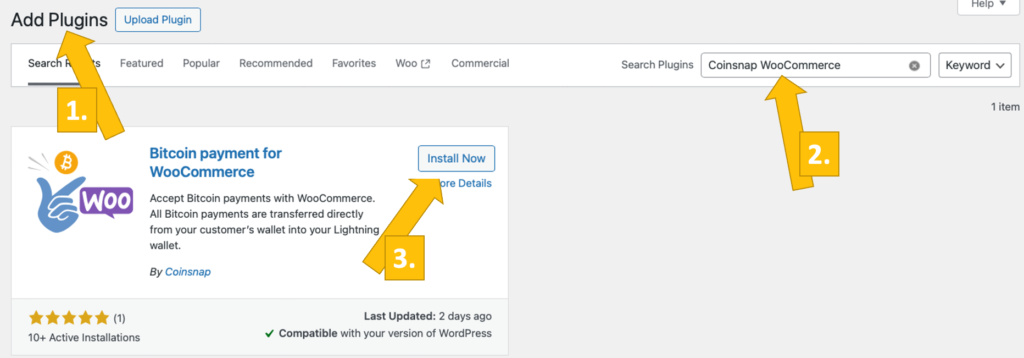
2) Create your Coinsnap account & connect your Lightning wallet (3 minutes)
- Open Coinsnap and sign up with your email.
- Add a store name [1] and your Lightning wallet/address [2]
- Copy your Store ID and API Key (see second image) and paste these into the Coinsnap plugin.
Privacy win: Because settlement is non-custodial, there’s no KYB/KYC to start accepting BTC/LN to your own wallet.
All you need is a valid email (to receive your login link) and a Lightning wallet. And, you must enter a name for your store (which will show in statements, payment confirmations etc.).
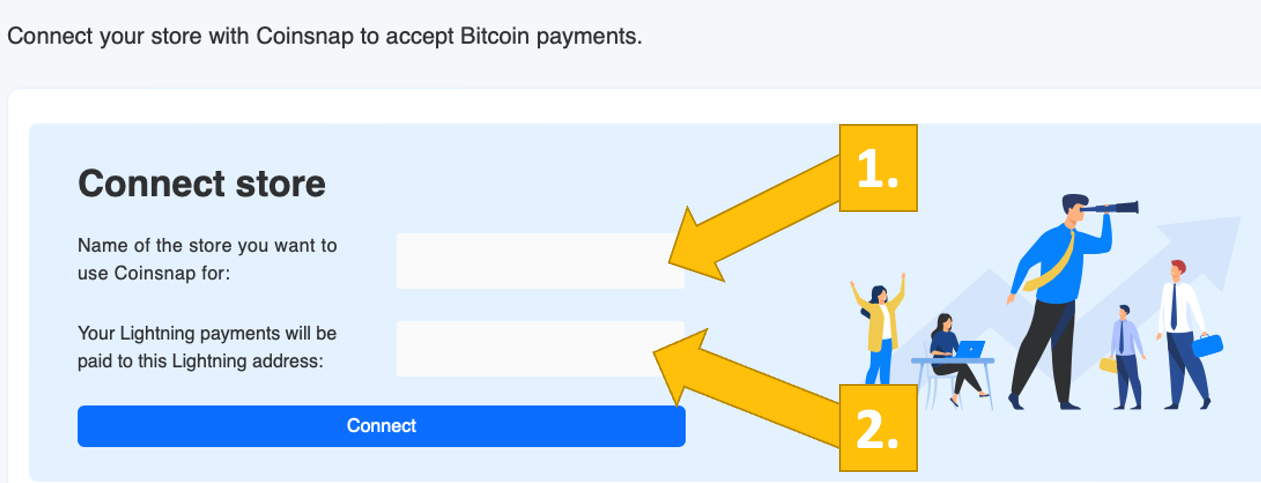
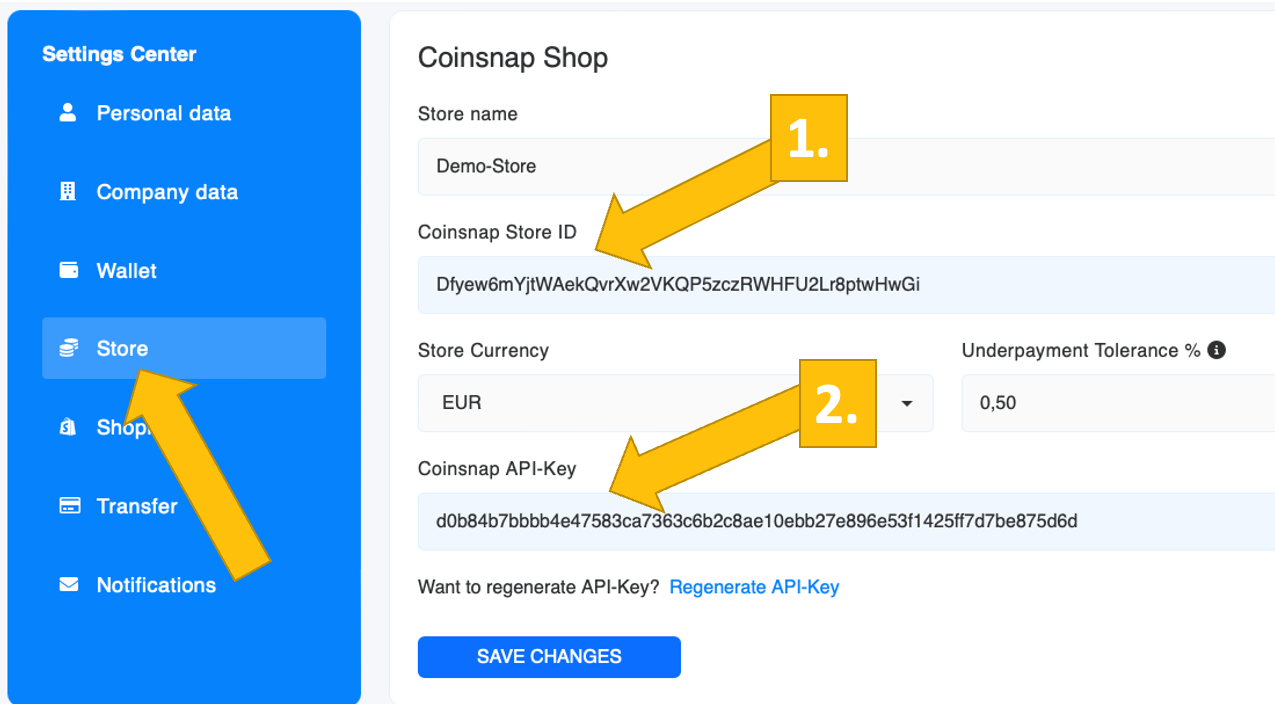
3) Enable Coinsnap in WooCommerce (2 minutes)
- In WordPress, go to WooCommerce [1] → Settings [2] → Coinsnap [3].
- Choose Coinsnap as your payment provider [4], and paste your Store ID [5] and API Key [6].
- Then go to Payments [7] where you Enable Coinsnap and click save.
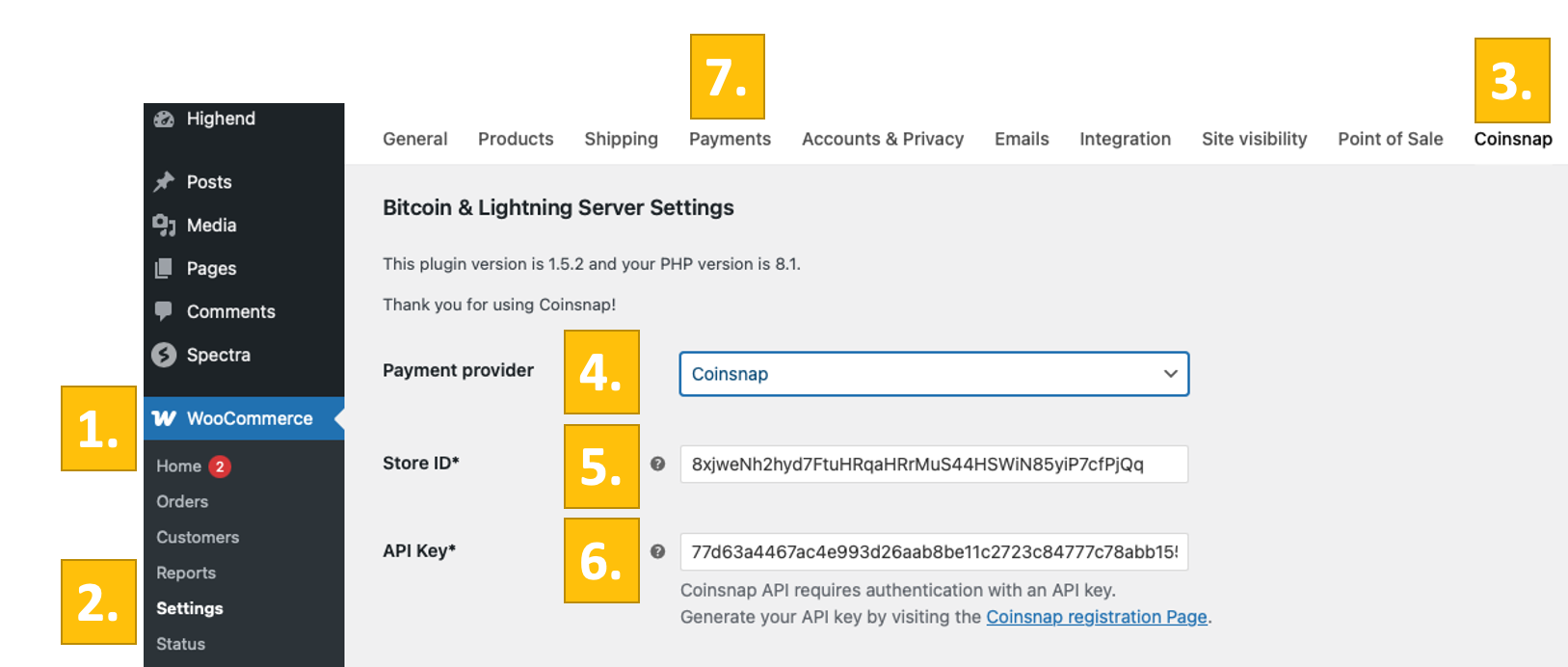
4) Test a real payment (2 minutes)
- Create a test product priced low (e.g., €1).
- After you’ve chosen Bitcoin/Lightning [2] in the first step of your checkout, now Check out [2].
- Scan the QR with your wallet (ideally not the one you use to receive payments with Coinsnap) and send the payment.
- Confirm the order status updates in WooCommerce and that Coinsnap shows the transaction details.
You’ll see the QR code now (second image) – just scan it with your Lightning wallet and conform the payment. (If you want to test on-chain payments, send the sats to the on-chain address listed beneath the QR code.)
If something’s off: Re-check the API key, your store URL, and that your wallet can pay Lightning invoices.
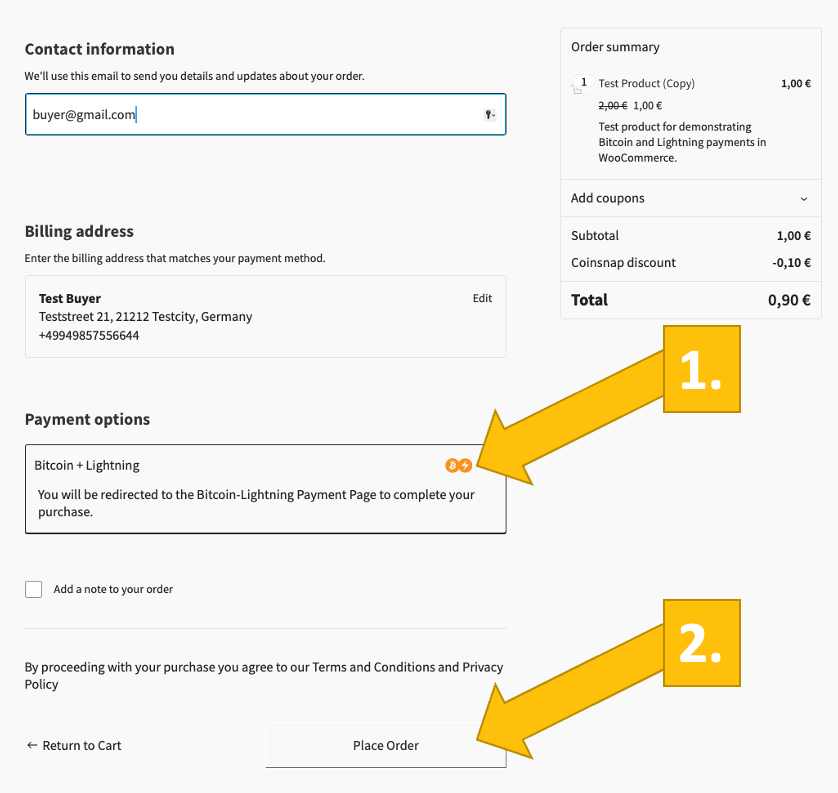
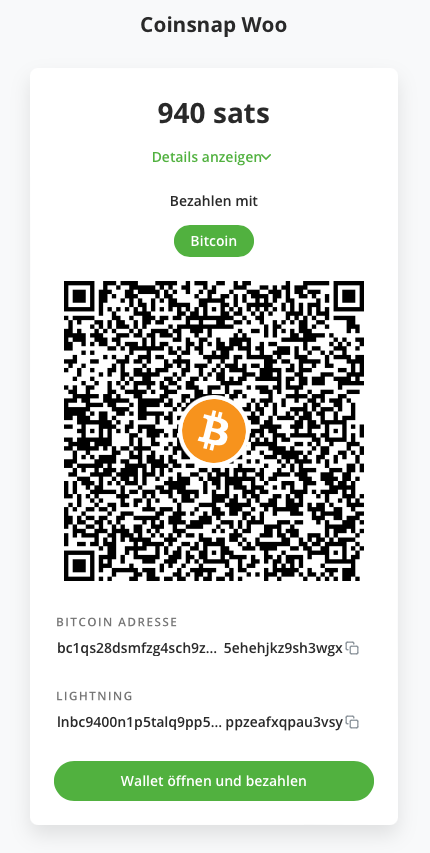
Optional: BTCPay Server & Fiat Settlement (5–10 minutes more, any time)
Merchants that value full sovereignty over their Bitcoin Lightning payment process should choose the BTCPay Server option that Coinsnap provides: If you connect your BTCPay Server to your WooCommerce via Coinsnap, you self-custody your funds (no third party holds your Bitcoin), pay zero platform fees, and control data, uptime, and compliance policies end-to-end. BTCPay Server supports both Lightning and on-chain, and lets you customize checkout, reporting, and routing—ideal for privacy-minded or high-volume stores that prefer no KYB, no vendor lock-in, and a payment stack they can audit and extend themselves, if they have the skills (NOTE: it’s not for beginners, coding skills and Lightning expertise required!). Learn more about BTCPay Server with Coinsnap
Merchants who want the reach and low fees of Bitcoin without holding BTC on their books—should opt for immediate fiat crediting that auto-converts Lightning/on-chain payments into EUR at the moment of sale and pays out to a personal SEPA bank account. This removes price volatility, simplifies accounting and VAT (no crypto treasury, no FX gains/losses tracking), keeps cash flow predictable for payroll and suppliers, and still preserves Bitcoin’s no-chargeback advantage. An elegant and easy to use solution for such merchants is to use Coinsnap with Bringin or DFX to off-ramp Lightning in real time. Learn more about Coinsnap + Bringin
A) Use the BTCPay Server wizard
If you’re a sovereignty fan, pair Coinsnap with your own BTCPay Server:
- Choose BTCPay Server in the gateway choice on the top of the Coinsnap tab in WooCommerce, and enter your BTCPay URL [1] and click Generate API Key [2]
- then confirm (twice), as requested by your BTCPay Server [see images 2 and 3]
- Save and test.
NOTE: you need to be logged in to your BTCPay Server before you start the process.
If done, you’ll enjoy full control while retaining Coinsnap’s smooth WooCommerce integration. Also, you don’t even have to register a Coinsnap account – you preserve full autonomy!
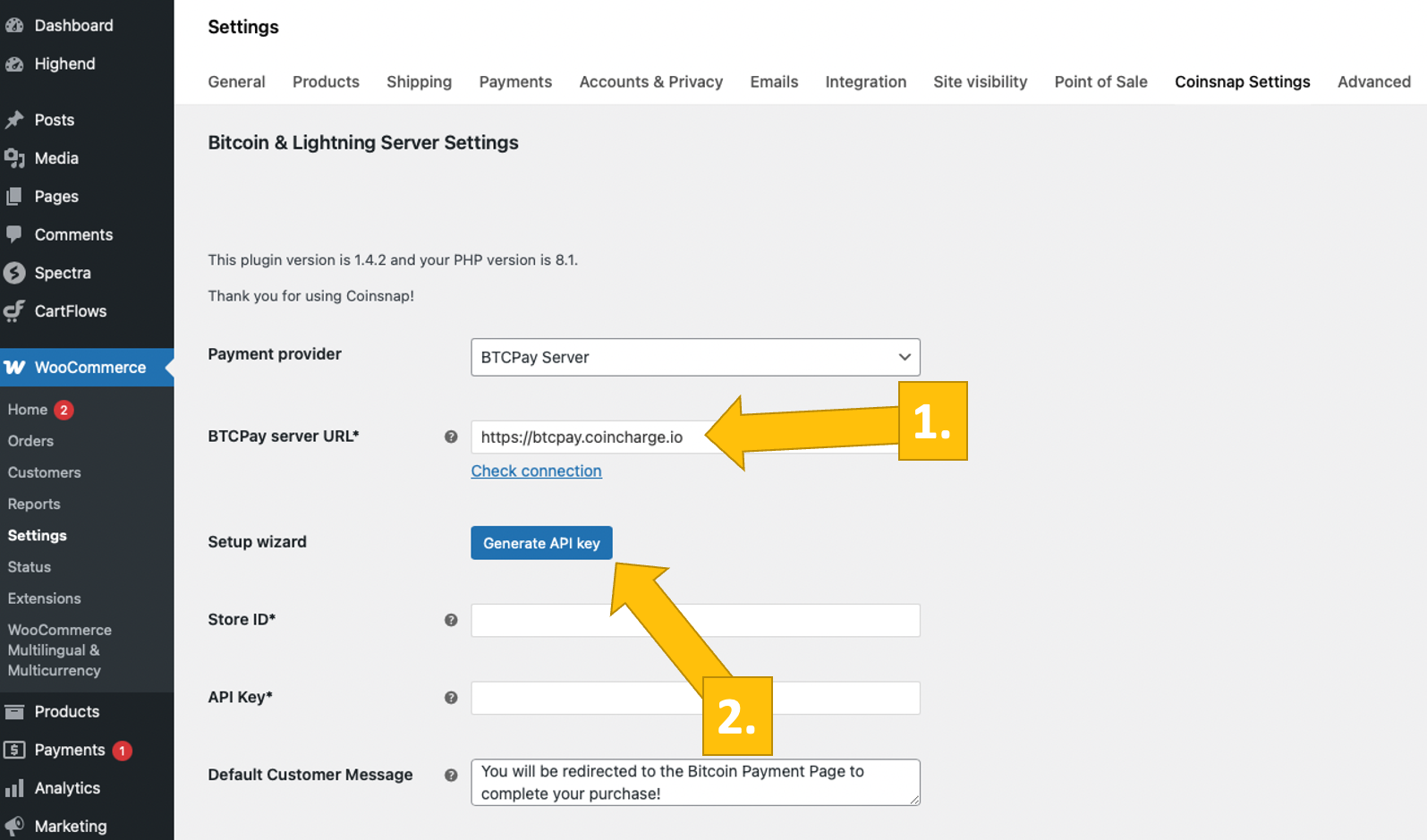
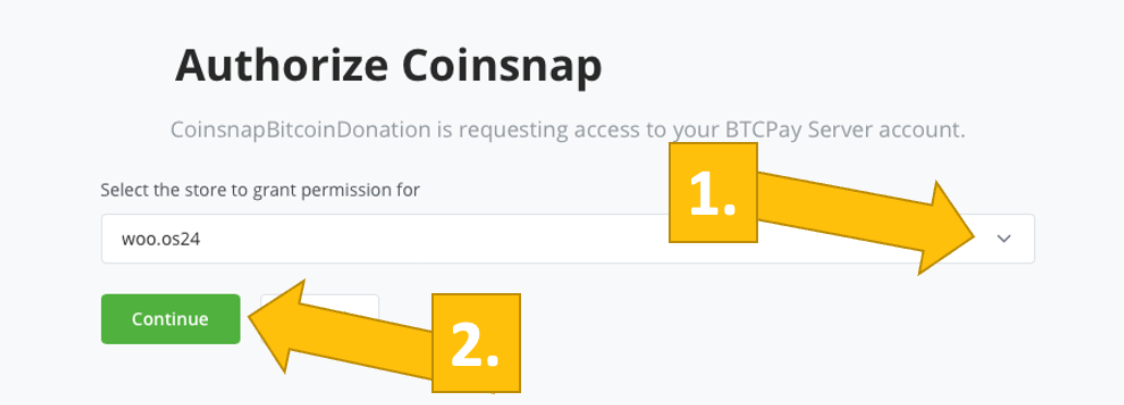
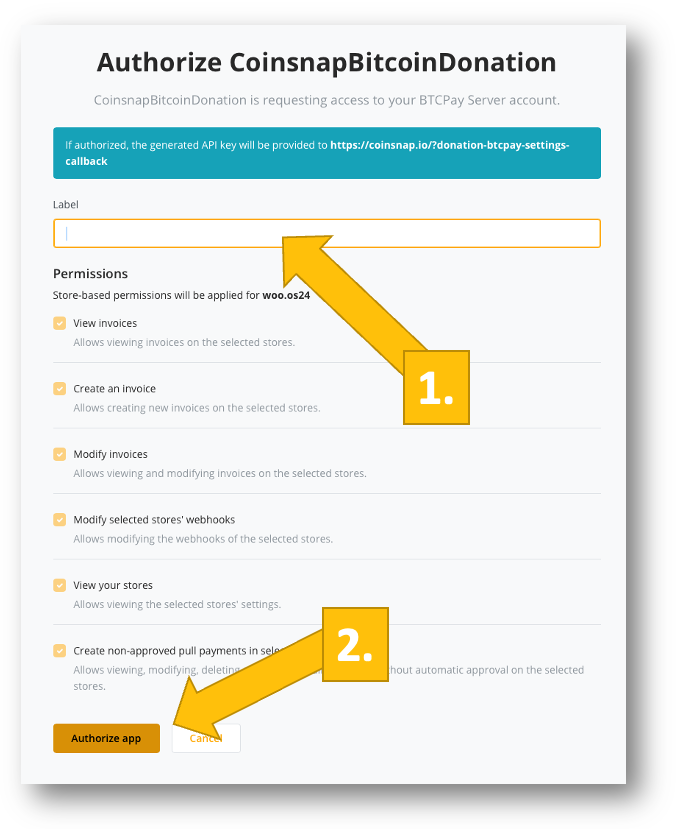
B) Enable automatic fiat settlement (Bringin)
Bringin is a Bitcoin-to-Euro service that gives you a personal Lightning address and a IBAN (EU bank account in your name). When you plug that Lightning address into Coinsnap, every Lightning payment from your WooCommerce checkout is auto-converted to EUR in real time and credited to your IBAN—no technical setup beyond pasting the address.
- Create a Bringin account here (KYC: ID + recent utility bill) and claim your Lightning address (e.g., storename@bringin.xyz).
- In your Coinsnap account → Settings → Wallet, paste that Bringin Lightning address.
Customers still pay with Bitcoin/Lightning at checkout, but the funds are now auto-converted to EUR and credited to your IBAN. You can transfer EUR to your bank account on demand.
With Coinsnap and Bringin you keep the reach and low-fee benefits of Bitcoin, but your accounting stays simple (euro in, euro out), volatility is removed, and funds can be moved to your regular bank account whenever you like.
If you need a more detailed, step-by-step guide on how to integrate Bringin with Coinsnap, look here!
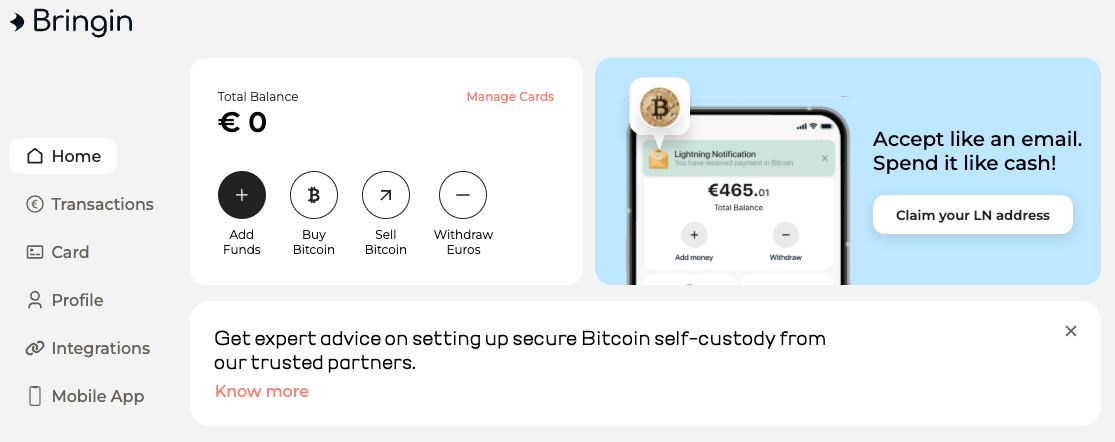
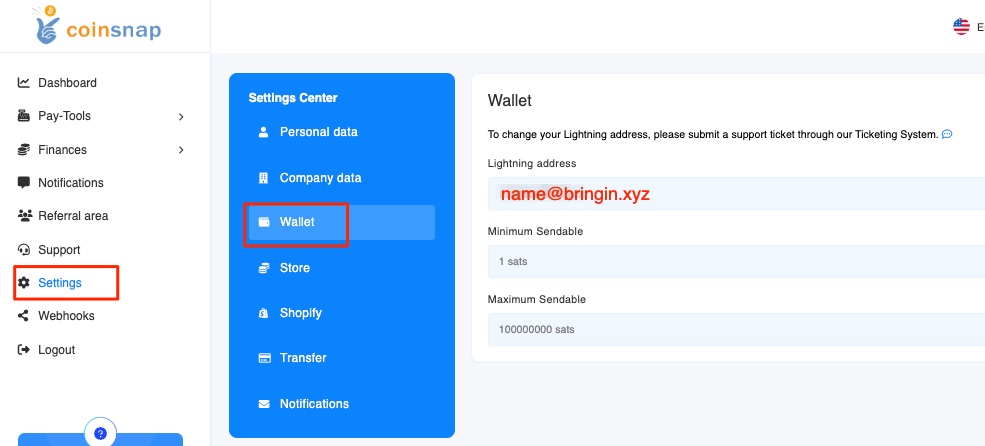
Configuration best practices
The best Bitcoin plugins like Coinsnap are built around most merchant’s needs—so, for example, with Coinsnap, most settings work out of the box; just sanity-check a few smart defaults and you’re set.
Pricing & rate locking
- Keep currency as your store’s default (EUR); the plugin handles the conversion amount displayed in Sats (Satoshis).
- Don’t worry about rate locking so the BTC amount holds for a short window – Coinsnap comes with a pre-set 10–15 minutes rate lock.
Refunds (no chargebacks)
- Bitcoin/Lightning are push payments; there are no card-style chargebacks.
- When you issue a refund, you send a new payment to the buyer’s address/invoice and save the payment record in the wallet you used for the refund.
Fraud & risk
- Because the customer initiates payment from their wallet, stolen card scenarios don’t apply.
- Keep your normal store policies (returns, warranties) and publish them clearly.
Compliance, accounting, and settlement: what matters
Before you flip the switch, get the basics right: compliance (your custody model determines whether KYB/KYC applies and which consumer/tax rules you must follow), accounting (log BTC amount, fiat value at payment time, exchange rate, and TXID/payment hash for clean books), and settlement choices (self-custody BTC/LN, automatic fiat payouts, or a hybrid).
The next section shows you what you should make your mind up about before you go live—and why it matters:
Compliance:
- Non-custodial (Coinsnap to your wallet): generally no KYB/KYC; still follow local tax and consumer rules.
- Custodial/fiat settlement (via partners): expect KYB/KYC and provider terms.
Accounting:
If you want to better understand the requirements for clean tax reports, read this article: https://coinsnap.io/accounting-and-tax-if-you-accept-bitcoin-payments-in-your-online-store/
Anyway, what you should know is:
- In your Coinsnap dashboard you’ll find detailed records of all transactions, featuring BTC amount, fiat value at payment time, exchange rate, invoice and order IDs, order number, and customer email.
- Export your financial statement CSV from Coinsnap regularly and reconcile with your wallet and accounting system.
- If you convert to fiat later, track gains/losses between payment time and conversion.
If you plan to hold the BTC you receive, connecting Coinsnap to CoinTracking automates transaction imports, cost basis and gains/losses tracking, and produces tax-ready reports—minimizing bookkeeping effort and reducing risk with your local tax authorities. Learn more about CoinTracking for TAX compliance here: https://coinsnap.io/cointracking-integrates-coinsnap/
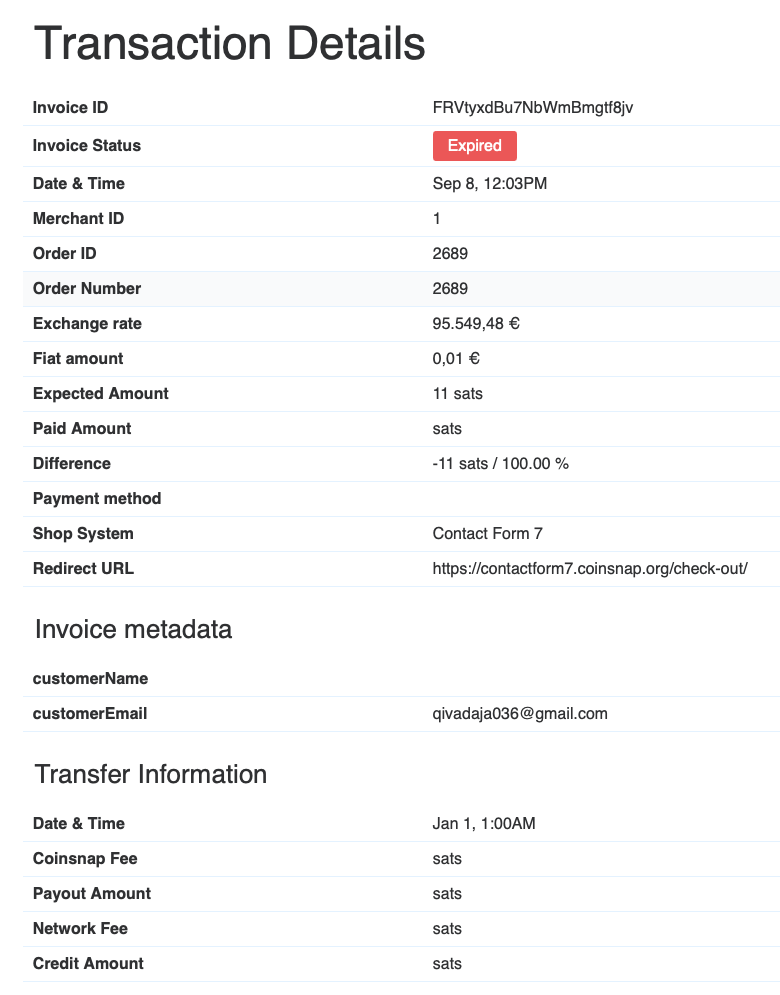
Settlement choices:
How your Bitcoin revenue lands in your books is up to you—pick the settlement path that fits your risk tolerance, cash-flow needs, and operational effort:
- Direct self-custody (Lightning, on-chain),
- Automatic fiat payouts (Bringin / DFX), or
- Hybrid (Lightning default; on-chain for large tickets; periodic conversion).
For a deeper understanding read this.
Troubleshooting: quick fixes
With mature, well-tested plugins, troubleshooting is rarely needed—and when it is, it often requires backend checks best handled by the provider; top solutions like Coinsnap include a support tab right in your dashboard so their tech team can quickly investigate and resolve issues.
- Payment received, order not updated: There might be issues with webhook/API credentials or that your site is blocking callbacks (security plugins, firewalls). That’s nothing you can fix by yourself–contact your support from your dashboard and write them a ticket. They will look into it and get back to you quickly.
- Customer paid wrong amount (on-chain): Use rate-locked invoices and show clear countdown; encourage Lightning for speed/precision.
- Duplicate pending orders: Since you do not know what caused the issues that prevented the processing of a payment, you can only try to contact the buyer via the email that you find in your transaction report in the dashboard.
Operations playbook (make it stick)
If you want smoother flows, fewer support hiccups, and higher conversion—especially from international, privacy-minded buyers—there are some proven tricks you should think about or implement.
By standardizing team steps (how to confirm payments, refund cleanly, reconcile weekly) and optimizing touchpoints (clear “Pay with Bitcoin/Lightning” cues, smart defaults, simple help links), you reduce friction and build trust—so more shoppers choose BTC and more of those payments succeed on the first try.
Here is what most successful Bitcoin merchants would recommend:
- Train support: Teach what a successful BTC/LN payment looks like, how to confirm, and how to process refunds (create a blog post for that and put a link into your checkout).
- Promote the option: Add “Pay with Bitcoin/Lightning” badges on product pages and at checkout; mention instant confirmation.
- If you can, offer a small discount on Bitcoin payments (i.e. 5%)–everybody loves a discount (and you save half the cost of this discount alone on credit card fees, not counting elimination of chargebacks and preventing fraud)!
- Offer both rails: Lightning by default, on-chain for high-value carts or customer request.
- Reconcile weekly: Export Coinsnap CSV, match to WooCommerce orders and wallet transactions.
Lightning vs. on-chain (in practice)
Understanding the difference between Lightning and on-chain matters because it directly affects your fees, speed, and checkout experience—and therefore your margins and conversion rate. It also determines how you account and settle (instant LN payouts vs. confirmed on-chain transfers), which defaults to set in WooCommerce, and when to offer a fallback so payments don’t fail on busy days.
- Fees: Lightning payments usually cost fractions of a cent because there’s no per-payment miner fee. On-chain payments include a miner fee that can rise with network congestion, so they’re better for fewer, higher-value transactions.
- Speed: Lightning settles in seconds and flips the order to “paid” immediately. On-chain typically needs 1–3 confirmations (often 10–30 minutes), which can delay, or in a few cases even prevent fulfillment.
- Checkout experience: Lightning is “scan and pay” with a countdown timer—fast and simple. On-chain often means copying an address/amount, with more risk of under/overpay.
- Reliability: Lightning needs channel liquidity; good providers manage this. Keep on-chain enabled as a safe fallback.
- When to use which: Default to Lightning for everyday and mid-sized orders or digital goods; offer on-chain for large tickets, treasury moves, or customers who prefer it.
Most merchants run Lightning first. If you have regular baskets with a value of more than $1.000, keep on-chain available as a fallback.
Mini FAQ – just to see if you understand it all
Does WooCommerce support Bitcoin natively?
No. You add BTC/LN with a plugin like Coinsnap (or self-host with BTCPay Server).
Do I need KYC/KYB?
Not for non-custodial BTC/LN payouts. Fiat settlement partners typically require it.
Can I get paid in euros automatically?
Yes—connect Bringin or DFX for automatic off-ramp to fiat (their onboarding applies).
Can I really get Bitcoin payment for WooCommerce in 10 minutes?
With mature plugins like Coinsnap you definitely can install, connect, and test your new WooCommerce Bitcoin payment in that window; allow extra time for design tweaks or advanced options.
Your 10-minute launch plan (recap)
-
Install Coinsnap
-
Create account (email) & add Lightning address
-
Paste Store ID & API key in WooCommerce
-
Enable Lightning (on-chain optional)
-
Test a €1 order
-
Go live.
Final thoughts on how add Bitcoin to WooCommerce in 10 minutes
If you want a faster, cheaper, and more resilient checkout, Lightning is the new default—and Coinsnap is the easiest way to bring it to WooCommerce. Start with Lightning in minutes, and plug in Bringin/DFX for fiat settlement when needed. Connect your BTCPay Server if you want sovereignty. That’s modern payments—without the headaches.


